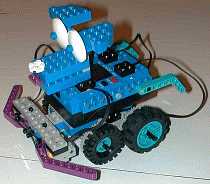More mechanical bugs?
OK, what the F, Decepticons?! This is so sci-fi it makes me physically ill.
Earlier today I wrote about this artist hiding mechanical crickets around the city, now we've got Robo-Bugs flying over anti-war rallies in DC?
Earlier today I wrote about this artist hiding mechanical crickets around the city, now we've got Robo-Bugs flying over anti-war rallies in DC?
Robotic fliers have been used by the military since World War II, but in the past decade their numbers and level of sophistication have increased enormously...
Naturally, no agency is admitting to having deployed insect-size spy drones. But a number of U.S. government and private entities acknowledge they are trying. Some federally funded teams are even growing live insects with computer chips in them, with the goal of mounting spyware on their bodies and controlling their flight muscles remotely.
The robobugs could follow suspects, guide missiles to targets or navigate the crannies of collapsed buildings to find survivors.
The technical challenges of creating robotic insects are daunting, and most experts doubt that fully working models exist yet.
The CIA secretly developed a simple dragonfly snooper as long ago as the 1970's. And given recent advances, even skeptics say there is always a chance that some agency has quietly managed to make something operational.

Vanessa Alarcon, a senior at NYU, saw them while working at an antiwar rally in Lafayette Square last month.

Others think they are, well, dragonflies -- an ancient order of insects that even biologistsconcede look about as robotic as a living creature can look.
All told, the nation's fleet of flying robots logged more than 160,000 flight hours last year -- a more than fourfold increase since 2003. A recent report by the U.S. Army Command and General Staff College warned that if traffic rules are not clarified soon, the glut of unmanned vehicles "could render military airspace chaotic and potentially dangerous."
But getting from bird size to bug size is not a simple matter of making everything smaller.
The Defense Department is trying, though.
Naturally, no agency is admitting to having deployed insect-size spy drones. But a number of U.S. government and private entities acknowledge they are trying. Some federally funded teams are even growing live insects with computer chips in them, with the goal of mounting spyware on their bodies and controlling their flight muscles remotely.
The robobugs could follow suspects, guide missiles to targets or navigate the crannies of collapsed buildings to find survivors.
The technical challenges of creating robotic insects are daunting, and most experts doubt that fully working models exist yet.
The CIA secretly developed a simple dragonfly snooper as long ago as the 1970's. And given recent advances, even skeptics say there is always a chance that some agency has quietly managed to make something operational.

Vanessa Alarcon, a senior at NYU, saw them while working at an antiwar rally in Lafayette Square last month.
"I heard someone say, 'Oh my god, look at those,' I look up and I'm like, 'What the hell is that?' They looked kind of like dragonflies or little helicopters. But I mean, those are not insects."Out in the crowd, Bernard Crane, a DC lawyer, saw them, too.
"I'd never seen anything like it in my life. They were large for dragonflies. I thought, 'Is that mechanical, or is that alive?' "That is just one of the questions hovering over a handful of similar sightings at political events in Washington and New York. Some suspect the insectlike drones are high-tech surveillance tools, perhaps deployed by the Department of Homeland Security.

Others think they are, well, dragonflies -- an ancient order of insects that even biologistsconcede look about as robotic as a living creature can look.
All told, the nation's fleet of flying robots logged more than 160,000 flight hours last year -- a more than fourfold increase since 2003. A recent report by the U.S. Army Command and General Staff College warned that if traffic rules are not clarified soon, the glut of unmanned vehicles "could render military airspace chaotic and potentially dangerous."
But getting from bird size to bug size is not a simple matter of making everything smaller.
The Defense Department is trying, though.
Read the full article, here, from The Washington Post



No comments:
Post a Comment